Let Dragons Be Evil by Dr. Emily Dowdell
The heroic protagonist fights the evil dragon and rescues those in mortal danger. We are attracted to these stories and the excitement of the challenge. It can be a source of hope when we struggle in our own battles to see the stark victory of good over evil. In the last thirty years, many children’s stories have drifted away from these themes. Our legends are less legendary, the line between the heroes and villains has become blurred. But there’s a developmental reason that we need exaggerated all-good or all-bad characters in children’s stories. Children need to be able to recognize what is good and what is bad, to develop their conscience, and it starts in these extremes.
The hope is that child-logic, which tends to categorize in black-and-white terms, is outgrown by adulthood. As the brain develops, it becomes more capable of discernment and critical thinking. With that comes the ability to recognize the multifaceted reality that no one is truly all-good or all-bad. However, the all-good and all-bad characters of our childhood stories help us as adults develop the extreme constructs from which to evaluate others in a more nuanced and compassionate way. Without them, there are no moral absolutes we can no longer appreciate the difference between virtuous and vicious behavior. In a General Audience in 1999, John Paul II predicted that a society with no moral framework would end up in a state of confusion. He said, “Evil exerts a frightening power of attraction which causes many types of behavior to be judged ‘normal’ and ‘inevitable’. Evil then grows, having devastating effects on consciences, which become confused and even incapable of discernment.”
There is an attractive element to retelling the story of the Disney villains in a light that makes them seem more human. These characters become less of a caricature of evil and much more relatable. Perhaps the adults who grew up watching Disney movies felt a sense of pity for the misunderstood “bad guy” or wanted to find a way to redeem the parts of themselves or close others that they saw in these evil characters. I know I did. I imagined that the evil sultan Jafar of Aladdin, while ambitious for the throne, was really out to protect Jasmine from a thief and a liar. I reversed the hero and the villain in this and many other stories growing up to try to make sense of the good and bad in my own story.
I am still extremely sympathetic to a good redemption arc, but I have come to realize that redemption only occurs if we retain a sense of what is good and bad. To suggest that all people are all good all of the time is simply untrue. It does not make space for the terribly evil actions that ordinary people can knowingly, or unknowingly, commit. I have had my utopian fantasies where I live in a world where every person feels completely understood, loved, and valued as they were created. Seeing individuals in my family long for that kind of affirmation, I too long for them to receive it. I want to believe that it is possible to get there. I want to believe in the inherent goodness in every person. But to get there, we can’t ignore the reality of evil. To get there, we have to recognize the truth of each person’s capacity for both good and evil. We must become aware of the good and bad within us and reorient ourselves to the good, again and again. We cultivate a sense of morality in ourselves and our children by encouraging growth in faith, hope, love, prudence, justice, fortitude, and temperance. We tell them stories where the hero defeats the dragon, to give them hope that they can, with God’s grace, overcome the darkness in their own minds and hearts. Because the truth is, the Savior has already won and His kingdom, while not yet in its full glory, is established. So, we fight for the good so that we and those we love can inherit a place in this kingdom.
Image: Saint George Defeating the Dragon by Johan Konig, c. 1630

